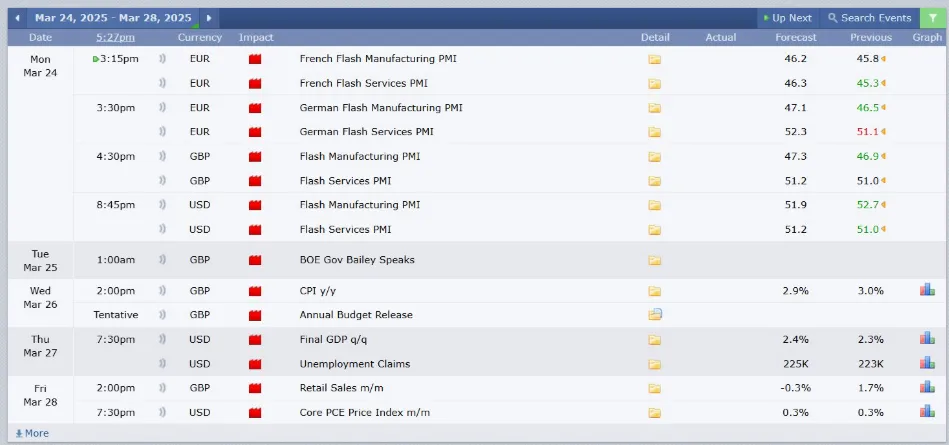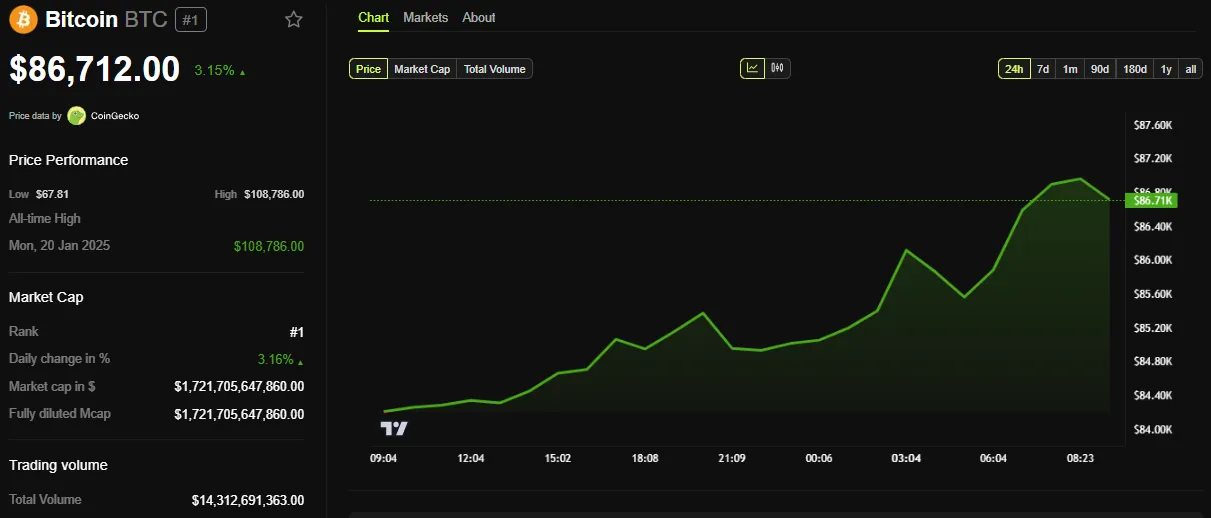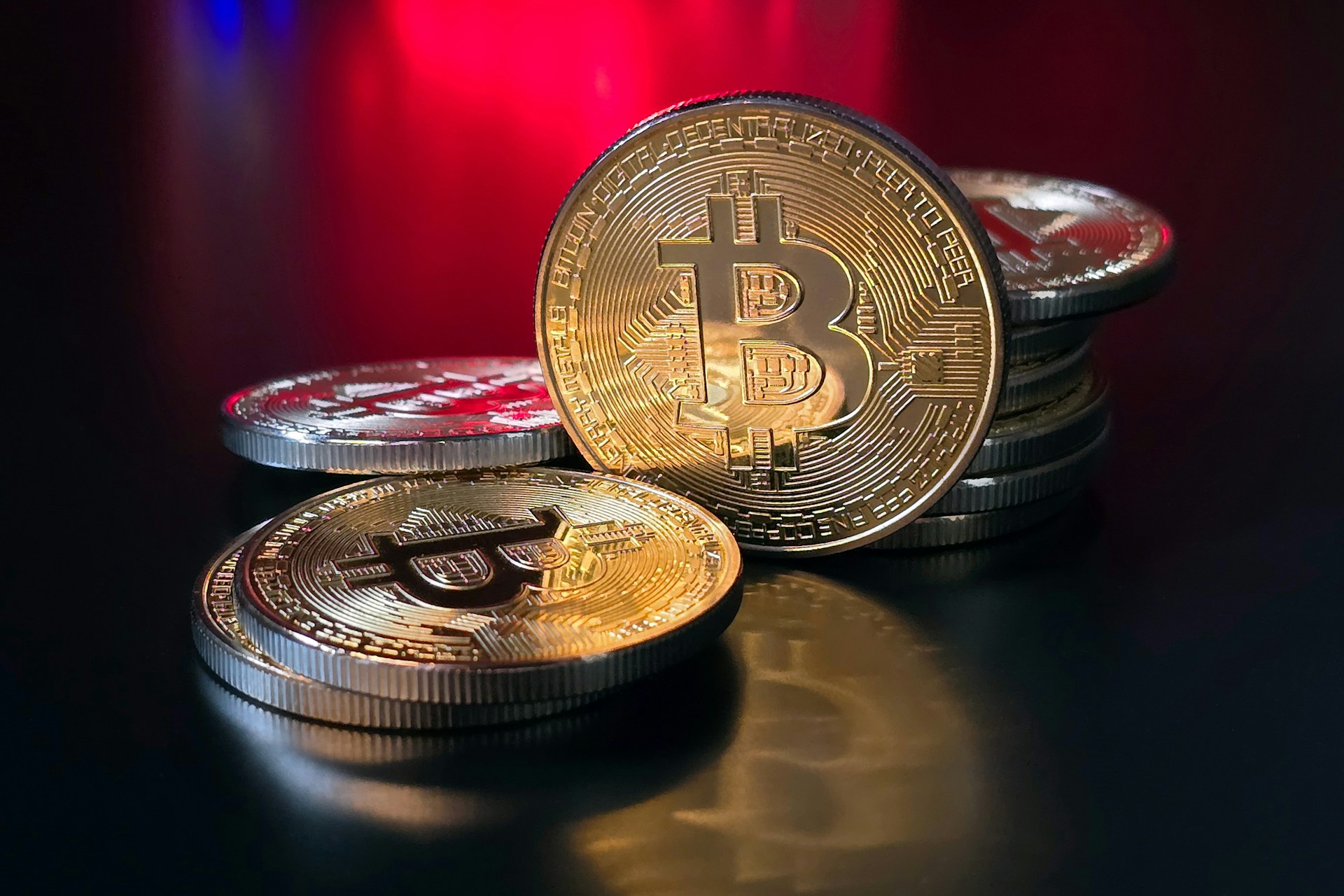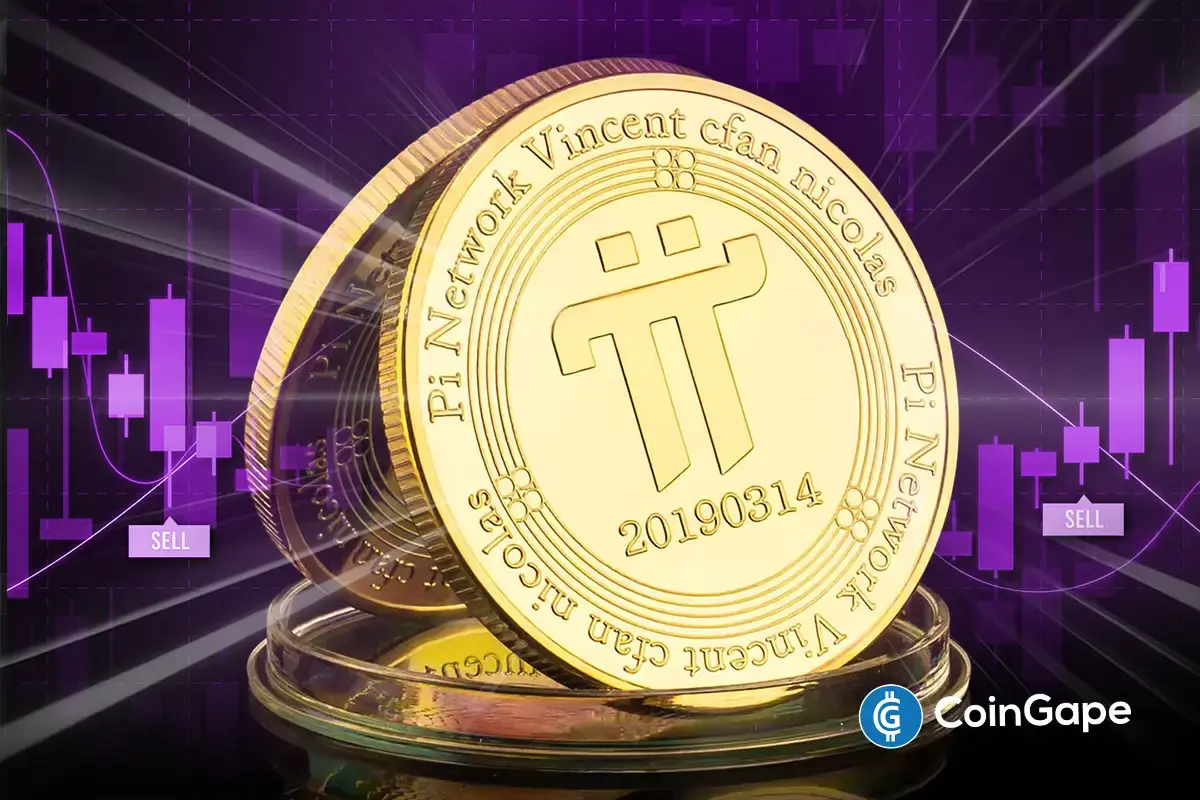Bitcoin
US Economic Data This Week: Key Events Shaping Bitcoin

This week in crypto, several US economic data releases will influence Bitcoin (BTC) and crypto market sentiment in general.
Meanwhile, Bitcoin’s price still hovers near the $87,000 threshold, defending against further downside despite being devoid of sufficient catalysts to activate its upside potential.
US Economic Data With Crypto Implication This Week
This week, five US economic data sets, including services and manufacturing PMI, consumer confidence, initial jobless claims, GDP, and PCE Index, interest crypto traders and investors. Here is how they could sway sentiment.

Services and Manufacturing PMI
The S&P Global US Services and Manufacturing PMI data, due on Monday, March 24, will gauge the health of these critical sectors. Recent trends show manufacturing holding strong at 52.7, while services follow at 51.0.
Strong manufacturing and services PMI readings could boost risk appetite, potentially lifting Bitcoin as investors seek high-yield assets. Conversely, readings below 50 would signal economic contraction, stoking recession fears and effectively driving safe-haven flows away from crypto.
With Trump’s pro-growth policies gaining traction, any upside surprise could amplify bullish sentiment, though persistent weakness may temper enthusiasm.
“A busy week as we come to the end of Q1 2025. How will the markets close out the first quarter of Trump’s new term?” analyst Mark Cullen of AlphaBTC posed.
Consumer Confidence
Tuesday’s Consumer Confidence Index from The Conference Board, expected around 10 AM ET, will reflect spending attitudes amid economic uncertainty. Despite solid job growth, February’s drop to 98.3—its steepest since 2021—hints at unease.
A rebound to the median forecast of 95.0 could signal waning retail optimism, a key driver for Bitcoin’s retail-heavy market, pushing prices higher.
However, if confidence sinks further, dovish Federal Reserve (Fed) expectations might grow, offering mixed outcomes. Liquidity hopes could buoy BTC price, but risk-off moves might dominate.
Initial Jobless Claims
Thursday’s Initial Jobless Claims report will track labor market strength, showing the number of US citizens filing for unemployment insurance.
The 223,000 reading for the week ending March 15, slightly below the expected 224,000, suggested a cooling economy, a focal point for Fed policy. It extended positive sentiment after the week ending March 8, where initial jobless claims in the US were 220,000, compared to an expected 225,000.
This time, however, the median forecast is a slight bump in initial jobless claims to 226,000 for the week ending March 22.
Higher claims could spark recession jitters, nudging investors toward Bitcoin as a hedge against instability. On the other hand, lower claims might bolster traditional markets, siphoning capital from crypto. With the Trump administration eyeing labor boosts, this data could pivot sentiment sharply.
GDP
The GDP second revision for Q4 2024, out Thursday, is forecasted at 2.3%. Stronger growth could dampen Bitcoin’s appeal as a risk asset if investors favor equities, especially with revised 2024 figures showing a 3% annual rise.
A weaker print might fuel rate-cut speculation, enhancing BTC’s allure as a store of value. Crypto traders are watching how this aligns with recent Bureau of Economic Analysis (BEA) updates signaling strong consumer spending.
Meanwhile, Bitcoin OG and economist George Selgin challenge claims that a Strategic Bitcoin Reserve would boost GDP. The finance expert argues that Bitcoin’s price growth does not directly or significantly influence a country’s economic output.
“…But that [Bitcoin] price has no definite and substantial bearing on GDP, so by stocking up on Bitcoin the gov’t does not grow the GDP,” he explained.
This standpoint stems from Trump’s March 2025 Executive Order creating a Strategic Bitcoin Reserve using forfeited assets. Selgin and others criticize this as a misuse of public funds.
PCE Index
Meanwhile, the Fed’s preferred inflation gauge, the PCE Index (Personal Consumption Expenditures), is due on Friday. The index for February will follow January’s 2.5% year-on-year (YoY) rise.
A hotter-than-expected core PCE (excluding food and energy) could delay rate cuts, pressuring Bitcoin downward as tighter policy looms. A softer reading might ignite a rally, reinforcing hopes of monetary easing. With inflation stickiness lingering, this release could dictate BTC’s near-term trajectory.
Crypto markets remain on edge, with these events poised to shape Bitcoin’s path amid changing US economic narratives.

BeInCrypto data shows BTC was trading for $86,712, up by over 3% in the last 24 hours.
Disclaimer
In adherence to the Trust Project guidelines, BeInCrypto is committed to unbiased, transparent reporting. This news article aims to provide accurate, timely information. However, readers are advised to verify facts independently and consult with a professional before making any decisions based on this content. Please note that our Terms and Conditions, Privacy Policy, and Disclaimers have been updated.
Bitcoin
Is Bitcoin About To Skyrocket Or Crash? What Truflation Says


In the March 27, 2025 analysis, titled “Where is Bitcoin headed next? A Signal hidden in Real-Time Data,” Truflation highlights a recurring phenomenon: each time its inflation index experiences a pronounced downtrend that later pauses or reverses, Bitcoin has tended to surge soon afterward.
Where Is Bitcoin Headed Next?
Truflation’s research points to a backdrop shaped by the aftermath of COVID-19, when central banks worldwide slashed interest rates to almost zero and funneled liquidity into the economy. That period of easy money overlapped with Bitcoin’s run to all-time highs in 2021. By 2022 and 2023, however, persistent inflation took hold, prompting the US Federal Reserve to reverse course. Interest rate hikes and quantitative tightening became the primary tools for fighting price pressures, with the Federal Reserve explicitly aiming to bring consumer price inflation down to 2%.
According to the Truflation report, real-time inflation readings reached as low as 2% in June 2023. The official Consumer Price Index (CPI), published by the Bureau of Labor Statistics, mirrored that pattern about a month and a half later, bottoming out at 3% in July 2023. Yet from mid-2023 onward, Truflation’s index did not simply keep dropping in a straight line. Instead, it oscillated between higher and lower bounds, demonstrating a cyclical pattern of disinflation that would then stabilize or reverse course. Truflation now believes that each of these cyclical “inflection points” closely correlates with subsequent upswings in Bitcoin’s price.
The report references four distinct periods from September 2023 to September 2024 when Truflation’s index trended downward and then either flattened or rebounded. In each of those cases, Bitcoin’s price rose soon after. Truflation suggests that a fifth such event may now be unfolding: the inflation index dropped steeply in early 2025, hitting around 1.30%—a level not seen in several months—before rebounding to 1.80%. This situation is reminiscent of previous disinflation troughs that, based on Truflation’s data, presaged a new wave of Bitcoin buying.
“When Truflation’s disinflation trend pauses or reverses, Bitcoin tends to rally shortly after. This pattern has repeated a few times already — and if history rhymes, it may be unfolding once again soon,’” the analysis states.
The underlying reason, Truflation explains, revolves around Bitcoin’s forward-looking nature and its sensitivity to changes in liquidity conditions. Strong disinflation usually prompts speculation that the Federal Reserve may be done raising rates and could soon turn dovish. While steep and unrelenting disinflation can trigger fears of recession, a slowdown or pause in that disinflation trend often reassures markets that the economy is not sliding into an economic downturn.
This “soft landing” scenario emboldens risk-on sentiment. Traders and investors who believe that inflation has been subdued enough to delay additional tightening—or to accelerate rate cuts—frequently channel their optimism into assets like Bitcoin.
The report acknowledges that no single piece of data, including Truflation’s own, holds absolute sway over an asset as complex and widely traded as Bitcoin. However, it emphasizes that real-time inflation expectations reverberate throughout global markets, influencing equities, commodities, and foreign exchange trading, in addition to crypto. By anticipating shifts in those expectations, some investors may find themselves ahead of the curve when official CPI reports and central bank pronouncements finally confirm or contradict the evolving trend.
“Truflation doesn’t influence Bitcoin in a vacuum. No single data source ever does. But inflation expectations ripple across a wide range of markets — from equities to commodities — and especially into bond yields and forex markets,” the analysis concludes.
At press time, BTC traded at $84,461.

Featured image created with DALL.E, chart from TradingView.com

Editorial Process for bitcoinist is centered on delivering thoroughly researched, accurate, and unbiased content. We uphold strict sourcing standards, and each page undergoes diligent review by our team of top technology experts and seasoned editors. This process ensures the integrity, relevance, and value of our content for our readers.
Bitcoin
Strategic Bitcoin Reserve Proposed by Brazil’s VP Advisor


Brazil’s Vice President Geraldo Alckmin’s (PSB) chief of staff, Pedro Giocondo Guerra, underscored on Wednesday the importance of establishing a national strategic Bitcoin reserve. Guerra was speaking at the swearing-in ceremony of the new president of the FPBC (Parliamentary Front for Competitive Brazil), Deputy Júlio Lopes (PP-RJ), while representing the government of President Luiz Inácio Lula da Silva (PT).
“Rigorously debating the constitution of a sovereign reserve of bitcoin value is in the public interest and will be decisive for our prosperity. After all, Bitcoin is digital gold, the gold of the internet. It’s a technology that allows us to transmit wealth from one end of the planet to the other quickly and store the fruits of our labor efficiently and securely,” Guerra stated.
Will Brazil Get A Strategic Bitcoin Reserve?
His remarks highlighted Bitcoin’s intrinsic appeal—particularly its digital scarcity and deflationary design, in contrast to fiat currencies that can be printed at will. Guerra noted that an official BTC reserve might bolster the country’s resilience and adaptability, especially amid global economic and geopolitical fluctuations.
Notably, Congressman Eros Biondini (PL-MG) has introduced PL 4501/2024, which would permit the creation of a Sovereign Strategic Reserve of Bitcoins—referred to in the bill as RESBit. According to Biondini, the primary goal is to guard Brazil against currency fluctuations and geopolitical uncertainties by diversifying the government’s international reserves.
The text proposes a limit of 5% of the country’s international reserves—which totaled $366 billion in December—for Bitcoin acquisitions. Should it pass, Brazil would be authorized to invest as much as $18.3 billion in Bitcoin, based on the reserve’s valuation at the time the bill was drafted.
Currently under review by Rapporteur Luiz Gastão (PSD-CE) in the Lower House’s Economic Development Committee, the bill sets forth guidelines for gradual acquisition and emphasizes robust security measures, using cold wallets and advanced AI- and blockchain-based monitoring.
The legislation details how the Central Bank and the Ministry of Finance would jointly manage RESBit, ensuring transparency through regular biannual reports to both the public and Congress. In addition, the text addresses the need for educational and innovation programs, including specialized courses on blockchain, crypto-economics, and cybersecurity, as well as incentives like tax benefits for crypto-related startups.
Related Reading: Trump Endorses Pro-Bitcoin Senator Lummis: ‘Make US The Crypto Capital’
A technical advisory committee composed of experts in blockchain, digital economy, and cybersecurity would also be established to ensure rigorous oversight and to foster collaboration with international regulators and research institutions. The proposal cites global precedents, such as El Salvador’s adoption of Bitcoin as legal tender, the United States’ approval of BTC ETFs, China’s investment in blockchain and digital currency efforts, Dubai’s success in developing a blockchain-friendly business environment, and the EU’s regulatory framework for digital assets.
In its justification section, the bill argues that Brazil is already one of the countries with the highest rate of cryptocurrency adoption, yet government policy has not kept pace with the rapid evolution of this market.
According to the text, “The creation of RESBit will allow Brazil to diversify its international reserves, reducing exposure to foreign exchange fluctuations and geopolitical risks while increasing economic resilience. This measure will also position Brazil as a regional leader in financial and technological innovation, attracting external investment and strengthening our presence in the digital economy.”
At press time, BTC traded at $86,205.

Featured image created with DALL.E, chart from TradingView.com

Editorial Process for bitcoinist is centered on delivering thoroughly researched, accurate, and unbiased content. We uphold strict sourcing standards, and each page undergoes diligent review by our team of top technology experts and seasoned editors. This process ensures the integrity, relevance, and value of our content for our readers.
Bitcoin
Bitcoin Bet Grows Bigger: The Blockchain Group Snaps Up 580 BTC


The Blockchain Group, a France-based blockchain solutions firm, recently announced its largest Bitcoin (BTC) purchase to date, acquiring 580 BTC. This marks the company’s third BTC acquisition since it began buying the digital asset in November 2024.
The Blockchain Group Buys 580 Bitcoin
In its most significant BTC acquisition so far, The Blockchain Group has purchased 580 BTC for approximately $50.64 million at an average price of $88,020 per coin. According to the announcement, the purchase was made through its Luxembourg-based subsidiary.
Notably, the acquisition was financed through proceeds raised from a convertible bond issuance announced on March 6. The move aligns with the firm’s Bitcoin Treasury strategy.
To recall, The Blockchain Group made its first BTC purchase in November 2024, acquiring 15 BTC at an average cost of $68,785 per coin. Its second purchase followed in December 2024, when it bought 25 BTC at an average price of roughly $97,692.
Following its latest acquisition, the company’s total BTC holdings now stand at 620 BTC, with a total net asset value of slightly over $54 million at current market prices.
According to data from Yahoo! Finance, The Blockchain Group’s stock (ALTBG.PA) closed today’s trading session at €0.4975 ($0.54), up 3.09% on the day. On a year-to-date basis, the company’s shares have surged by an impressive 65.78%, suggesting that its exposure to BTC has positively impacted its valuation.

The Blockchain Group’s official website states that its pivot to Bitcoin is part of a broader strategy to optimize the use of its excess cash and financial instruments. Since its first BTC acquisition, the company’s stock has risen by 225%.
Corporate BTC Adoption To Grow In 2025
Corporate adoption of Bitcoin is expected to pick up even further in 2025, driven not only by the digital asset’s intrinsic value but also by a favorable regulatory environment under pro-crypto US President Donald Trump’s administration.
Earlier this week, the largest corporate holder of Bitcoin, Strategy, acquired an additional 6,911 coins, pushing its total holdings beyond 500,000 BTC. In the same vein, US-based financial services firm Fold Holdings announced the addition of 475 BTC to its corporate treasury earlier this month.
As corporate adoption grows, several US states have also begun legislative processes to add BTC to their treasuries. For instance, Utah and Kentucky have recently made significant strides with their BTC reserve bills.
Additionally, Mexican billionaire Ricardo Salinas recently revealed that close to 70% of his investment portfolio is allocated to Bitcoin and related assets. At press time, BTC trades at $86,838, down 1.1% in the last 24 hours.

Featured Image from Unsplash.com, charts from Yahoo! Finance and TradingView.com

Editorial Process for bitcoinist is centered on delivering thoroughly researched, accurate, and unbiased content. We uphold strict sourcing standards, and each page undergoes diligent review by our team of top technology experts and seasoned editors. This process ensures the integrity, relevance, and value of our content for our readers.
-

 Market23 hours ago
Market23 hours agoXRP Price Slides Slowly—Is a Bigger Drop Coming?
-

 Regulation15 hours ago
Regulation15 hours agoFDIC Revises Crypto Guidelines Allowing Banks To Enter Digital Assets
-

 Market24 hours ago
Market24 hours agoTerra’s Crypto Claims Portal Opens Soon: Key Dates and Info
-

 Altcoin23 hours ago
Altcoin23 hours agoWhy Is Pi Network Coin Price Up 5% Despite Altcoins Market Correction?
-

 Altcoin15 hours ago
Altcoin15 hours agoShiba Inu Price Set To Repeat History? Falling Wedge Pattern Shows A Rally
-

 Market19 hours ago
Market19 hours agoHedera Falls 4% as Bears Dominate: What’s Next for HBAR?
-

 Altcoin19 hours ago
Altcoin19 hours agoWhy the US SEC Is Delaying the Ripple Case?
-

 Ethereum18 hours ago
Ethereum18 hours agoEthereum Fails To Break $2,100 Resistance – Growing Downside Risk?





















